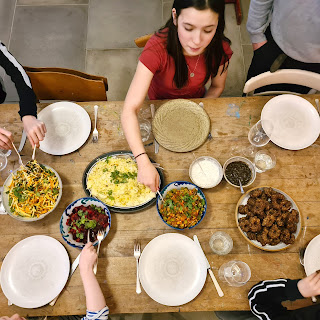Mangoes and coconuts for Ugadi, and one of India's oldest foods
One part of #cookingtheyear that I am learning a lot about, are the many different calendars used across the globe. The sun, moon and stars may shine equally and predictably, moving only a tiny amount over the millenia [although - as I discovered when reading about Makar Sakranti - enough to matter in some calendars] but there are multiple different ways to use them in deriving the staging-posts of the year.
The first new moon after the spring equinox is a conjunction of lunar and solar calendars that is the start of the New Year in several cultures. It is observed as Ugadi or Gudhi Padwa in many parts of south India; as Cheti Chand among the Sidhi people who originate from a region that is now in Pakistan; among the followers of Sanamahism, an animistic religion that probably predates Hindu practices. But it is by no means the only or even primary 'New Year' for the subcontinent - Vaisakhi is coming up, which seems to be more widely celebrated. The diversity of cultures and practices across the subcontinent comes truly home when considering the hundreds of languages and religions - and I am put to shame with how little I understand their inflections.
We had family staying for the weekend and it was a great excuse to cook up a south Indian feast in celebration. While I could have repeated - and improved on - the ugadi pachadi and the obattu (puran poli) we made at Makar Sakranti - I took the opportunity to try some new favoured Ugadi foods from the southern Indian states - rich with mango and coconut, which are symbolic of prosperity and happiness, among other meanings.
We made mavinakayi chitranna - a tangy mango rice with ancient roots, where cooked rice is mixed with spices and unripe mango; kosambari - a deliciously fresh, textured salad of mango, coconut, cucumber, urad dal and fresh coriander; and an okra (bindi) palya, the flavours of which took me back in an instant to my time in Kerala over fifteen years ago. It is extraordinary how food can so overwhelmingly bring you into a different time and place; more than a memory, a form of time travel. Alongside these, the thing that went down best with all the table were urad dal vadas with spiced yoghurt and a tamarind-mint-coriander smooth chutney. And for dessert I made sheer korma, a kheer made with sev - vermicelli - cooked in sweetened milk, with flaked almonds and pistachios. Kheer is a traditional prasada - temple food - and an easy, beautiful and totally delicious sweet that can be eaten hot but, in my opinion, is at its best chilled.
Vadas are probably one of the oldest foods in the subcontinent. In my efforts to become better informed, I've been reading Feasts and Fasts by Colleen Taylor Sen and learnt a lot about the history and use of urad dal, one of the native pulses to south India, unlike lentils and chickpeas, which originated further west. Vadas are mentioned in the earliest Indian cookbooks and are like a dal falafel - the urad dal, soaked but not cooked, are blitzed to a coarse mash, mixed with flavourings and - in some versions, but not the one I made - fermented for extra rise, before being shaped into balls or miniature doughnuts and deep-fried. It's safe to say they were a huge hit with all members of the extended family, along with the insanely tasty tamarind sauce - tamarind paste blitzed with fresh mint, coriander, ginger and spices. They were easy to make and a recipe that will certainly be repeated, but the whole meal was a massive hit. Fully vegetarian, no-one missed meat or fish, and all were super easy to make, with a great mix of sharp, fresh and rich cooked flavours and textures.
With apologies for the unstyled photos, as always it's a race against time to get a picture before everyone dives in to eat!


Comments